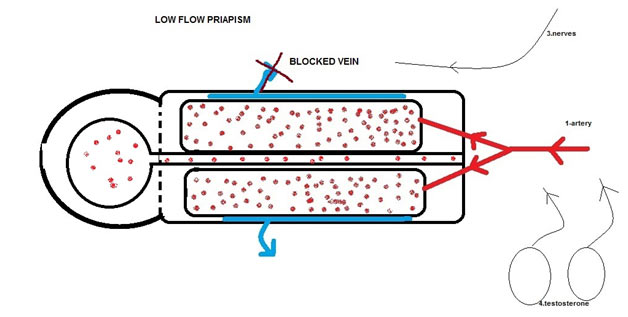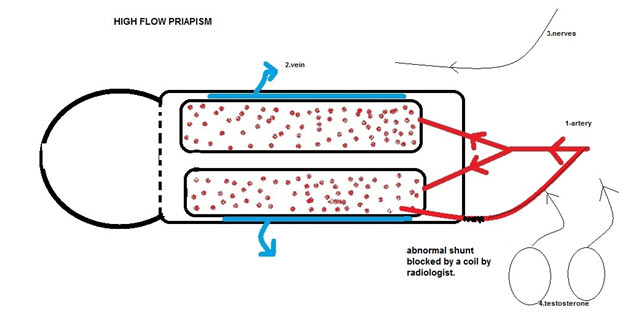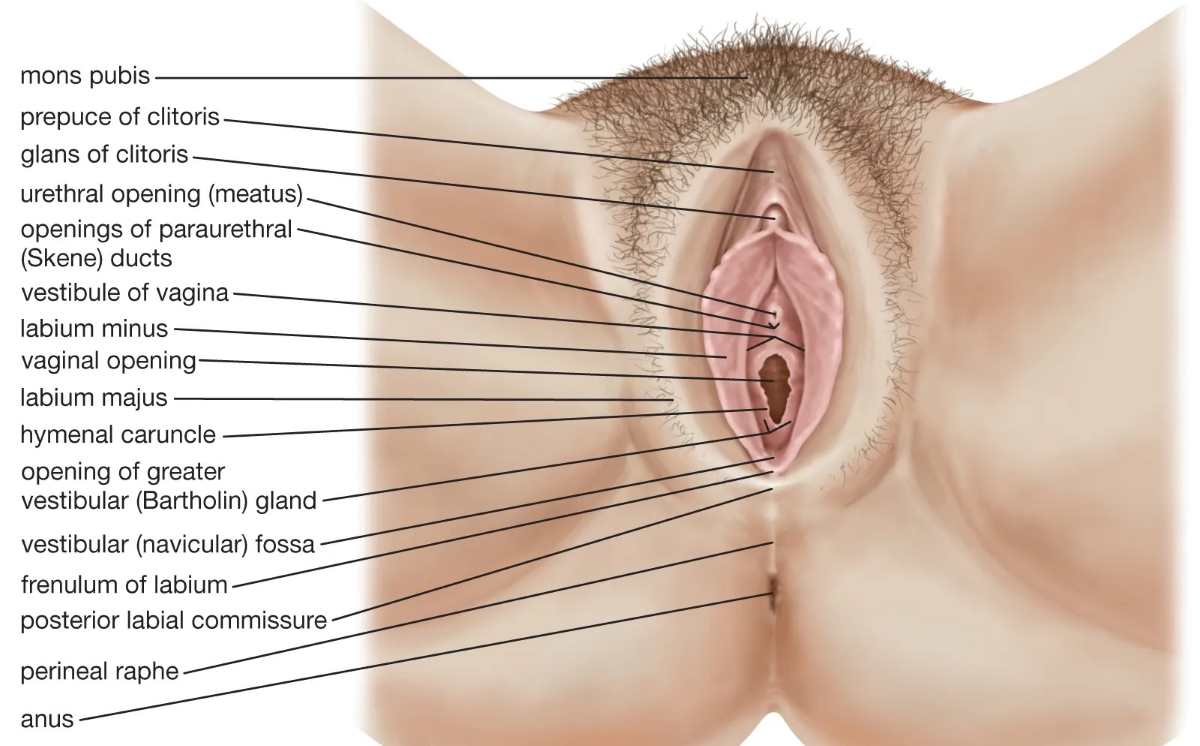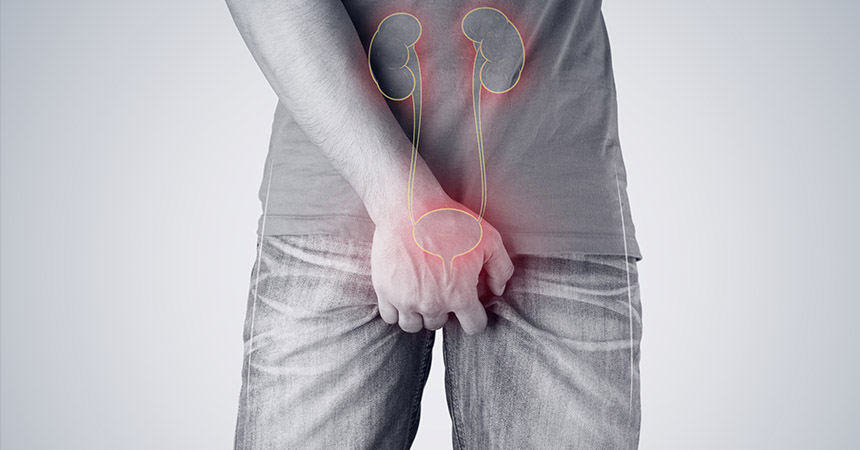Know About Priapism
Priapism is a medical condition that can be classified into two distinct categories, each requiring different treatment approaches. Before treatment, it is essential to identify the type of priapism and evaluate the severity of the patient’s condition. Understanding these classifications is vital for effective medical intervention. Here are the two main types of priapism:
Low-Flow (Ischemic) Priapism
Low-flow, or ischemic priapism, is the most prevalent type, accounting for over 80-90% of documented cases. This condition arises when there is inadequate blood flow from the erect penis back into the rest of the body. The lack of proper circulation can lead to significant discomfort and potential tissue damage if not treated promptly. Recognizing and addressing low-flow priapism swiftly is crucial for preventing long-term complications.
Low-flow Priapism or Ischemic priapism is the most common case of priapism among males; wherein it accounts for more than 80-90% of total documented cases of priapism. Low-flow Priapism cases are characterized to be as such when there isn’t adequate blood flow from the erect penis back into the rest of the human body.

High-Flow (Non-Ischemic) Priapism
High-flow, or non-ischemic priapism, is a rarer form of this condition. It occurs when the vascular system along the penis is obstructed or compromised. Although less common, high-flow priapism typically does not cause pain. Patients usually experience only minimal discomfort, which contrasts sharply with the significant pain associated with low-flow priapism. Understanding the differences between these types is crucial for effective diagnosis and treatment.

Stuttering Priapism
Stuttering priapism, also known as intermittent priapism, is a recurring form of ischemic priapism. Although the rarest type, it is considered the most dangerous due to its potential to cause extreme discomfort. This type involves repeated episodes of prolonged erections, which can severely impact the patient’s quality of life. Recognizing and treating stuttering priapism promptly is essential to prevent long-term complications and ensure patient well-being.

Symptoms of Priapism
Symptoms of priapism may vary depending on the type of priapism that is present. The common denominator for both types of priapism cases is for a prolonged erection of the penis lasting for up to four hours despite the lack of required stimulation, whether brought about physically or psychologically. Some identifying symptoms of low-flow or ischemic priapism cases are having stiff penile shafts (with soft penis tips) and increasing penile pain. Symptoms for high-flow or non-ischemic priapism is having a fully erect, but not fully rigid penile shaft and having minimal pain or discomfort. One more blatant symptom of having non-ischemic priapism is having a penis with visible trauma or injuries on the exterior of the penile organ.
Causes
In order to determine the causes of priapism, there must first be an understanding of what brings about the prolonged erection that makes up the medical condition. A male’s penis becomes fully erect when influenced or manipulated by physical or psychological stimulation. The stimulation then proceeds to cause the penis’s blood vessels to expand and muscles to relax, hereby intensifying the blood flow to the soft tissues tissues of the penis. Under normal circumstances, when stimulation is ceded, the muscles and blood vessels will gradually return to their regular state hereby rendering the penis to be in a flaccid state.
When there are irregularities or discrepancies in the blood flow of the penis at the moment of erection or stimulation, that is when priapism occurs and an unusual erection is maintained despite the lack of stimulation. There are several conditions involving the mechanics of blood vessels, muscles, and soft tissues, all of which may contribute to cases of priapism.
Blood-Related Conditions
Pre-existing blood conditions in human bodies are also likely suspects in bringing about priapism cases. Blood-related diseases like leukemia, anemia, and other hematologic dyscrasias have the capacities to trigger priapism cases in males. Another contributor to priapism cases include having glucose 6 phosphate dehydrogenase deficiency for this leads to decreased levels of NADPH, which may inevitably lead to cases of priapism.
Prescription Drugs and Medications
Studies have also shown that various prescription drugs and medications may serve as probable causes for priapism. Most notably, drugs that are used to treat erectile dysfunction are possible culprits of priapism. Other drugs include antidepressants like buproprion and fluoexitine; alpha blockers like doxazosin, tamsulosin, and terazosin; anxiety and panic disorder medications like olanzapine, hydroxizine, clozapine, lithium, and risperidone; hormone supplements like testosterone; medications for attention-deficit disorder like atomoxetine; and blood thinners like heparin.
Recreational Drugs and Alcohol
Low-flow or ischemic priapism can also be brought about by the consumption of alcohol or the use of marijuana, cocaine, and other forms of recreational drugs. The most common cause for non-ischemic or high-flow priapism is blunt trauma or injury that is directly inflicted on the penile organ, the pelvis (or any area within the pelvic region), and the area between the anus and the penis.
Other Contributing Factors
Other factors that contribute to priapism include penis-related cancers, gout, amyloidosis, insect-bite infections, and neurogenic disorders. Insects like the black widow spider and the Brazilian wandering spider in particular possess bites that may directly cause cases of priapism in their victims. Understanding these factors helps in diagnosing and treating priapism effectively.
Treatments for Ischemic Priapism
There are various ways to treat ischemic priapism, a condition where blood flow is restricted within the penile organ. This form of priapism is always considered an emergency and must be treated swiftly and precisely. The most common initial treatment for ischemic priapism involves draining the penis of blood and using medical remedies to restore healthy blood flow.
Aspiration Method
Blood is drained from the penis using an aspiration method with a small needle and syringe. This process is typically followed by flushing the penis with a saline solution. This treatment aims to alleviate the patient’s pain and remove deoxygenated blood from the penis. In some cases, this method alone is sufficient to cause the erection to subside, restoring normal blood flow and relieving symptoms.
Medication Injection
Another treatment option involves directly injecting medications into the penis to combat irregular blood flow and deoxygenation. Sympathomimetic medications like phenylephrine are injected to constrict the blood vessels, reducing blood flow to the penis. This constriction forces open the exiting blood vessels, allowing blood to leave the penis and restoring regular circulation. After this treatment, patients are observed for potential side effects like lightheadedness or elevated blood pressure.
Surgical Procedures
As a last resort, surgical procedures are viable options for treating ischemic priapism. In this procedure, surgeons redirect blood flow by manipulating the blood vessels to ensure proper function. This intervention is typically reserved for severe cases where other treatments have failed. Surgical options can provide a long-term solution to ischemic priapism, helping to restore normal penile function and prevent future occurrences.

Treatments for Ischemic Priapism
There are various ways to treat ischemic priapism, a condition where blood flow is restricted within the penile organ. This form of priapism is always considered an emergency and must be treated swiftly and precisely. The most common initial treatment for ischemic priapism involves draining the blood from the penis and using medical remedies to compensate for the lack of healthy blood flow.
Aspiration Method
Blood is drained from the penis using an aspiration method with a small needle and syringe. This process is typically followed by flushing the penis with a saline solution. This treatment alleviates the patient’s pain and removes deoxygenated blood from the penis. In some cases, this method alone is sufficient to cause the erection to subside, restoring normal blood flow.
Medication Injection
Another treatment option involves directly injecting medications into the penis to combat irregular blood flow and deoxygenation. Sympathomimetic medications like phenylephrine are injected to constrict the blood vessels, reducing blood flow to the penis. This constriction forces open the exiting blood vessels, allowing blood to leave the penis and restoring regular circulation. After this treatment, patients are observed for potential side effects like lightheadedness or elevated blood pressure.
Surgical Procedures
As a last resort, surgical procedures are viable options for treatment. Surgeons redirect blood flow by manipulating the blood vessels to ensure proper function. This intervention is typically reserved for severe cases where other treatments have failed. Surgical options can provide a long-term solution to ischemic priapism, helping to restore normal penile function and prevent future occurrences.
Prognosis
The prognosis of a patient with priapism greatly depends on various elements surrounding their condition. These elements include the duration and severity of symptoms, the patient’s medical history, and the age of the patient.
Concerns About Erectile Dysfunction
A common concern for victims of priapism is the likelihood of potency or erectile dysfunction once the medical condition subsides. This outcome largely depends on the promptness of treatment and recovery. Studies have shown that over 92% of men retained potency when the condition was treated within 24 hours. However, 22% of men suffered from chronic erectile dysfunction when the condition was left untreated for more than seven days. This highlights the importance of seeking immediate medical attention.
Complications from Trauma
In some cases involving trauma to the penile organ, infections may cause complications after priapism has subsided. Structural damage to the penile organ can create vulnerabilities, leaving room for future infections. Proper medical care is essential to address these complications and prevent long-term issues.
Underlying Conditions
While there have been some recorded deaths of patients experiencing priapism, these deaths were not necessarily caused by priapism itself. Instead, they were related to underlying blood diseases associated with the priapism condition. Identifying and treating these underlying conditions is crucial for improving the overall prognosis and preventing serious health outcomes.
Importance of Early Treatment
The key to a favorable prognosis lies in early and effective treatment. Prompt medical intervention can significantly reduce the risk of long-term complications and ensure better recovery outcomes. By addressing priapism swiftly, patients can minimize the impact on their sexual health and overall well-being.

Priapism for Women
While priapism, also known as Persistent Sexual Arousal Syndrome, primarily affects males, there is a female equivalent to this condition called clitoral priapism or clitorism. Clitoral priapism involves a prolonged and often painful engorgement of the clitoris, similar to the prolonged erection of the penis in male priapism. However, cases of clitoral priapism are extremely rare and are not typically considered medical emergencies to the same extent as male priapism.
Understanding Clitoral Priapism
Clitoral priapism occurs when there is excessive blood flow to the clitoris, leading to persistent engorgement and sensitivity. This condition can cause significant discomfort and pain for affected women. Unlike male priapism, which can result in severe complications if not treated promptly, clitoral priapism usually does not pose an immediate threat to health. However, it can still have a considerable impact on a woman’s quality of life, causing distress and discomfort.
Symptoms and Diagnosis
The symptoms of clitoral priapism include prolonged clitoral engorgement, persistent sensitivity, and pain in the genital area. These symptoms can last for several hours or even days. Women experiencing these symptoms should seek medical evaluation to rule out other potential causes and to receive appropriate treatment. Diagnosis typically involves a thorough physical examination and a review of the patient’s medical history to identify any underlying conditions that might be contributing to the priapism.
Causes of Clitoral Priapism
Several factors can contribute to the development of clitoral priapism. These include medications that affect blood flow, such as certain antidepressants and blood pressure medications. Other potential causes include hormonal imbalances, vascular disorders, and neurological conditions. In some cases, clitoral priapism may be idiopathic, meaning its cause is unknown. Understanding the underlying cause is crucial for determining the most effective treatment approach.
Treatment Options
Treatment for clitoral priapism focuses on relieving symptoms and addressing the underlying cause. Initial management may include the use of ice packs to reduce swelling and discomfort. In some cases, medications that affect blood flow, such as alpha-adrenergic agonists, may be prescribed to alleviate symptoms. If the priapism is caused by a medication, adjusting the dosage or switching to a different drug may be necessary.
Impact on Quality of Life
While clitoral priapism is not typically a medical emergency, it can significantly impact a woman’s quality of life. Persistent discomfort and pain can interfere with daily activities and sexual health. Therefore, addressing the condition promptly and effectively is essential to improve the patient’s well-being and overall quality of life.
Clitoral priapism is a rare but distressing condition that requires appropriate medical attention. Although it is not as immediately dangerous as male priapism, it can still cause significant discomfort and affect a woman’s quality of life. Understanding the symptoms, causes, and treatment options is crucial for managing this condition effectively. Women experiencing prolonged clitoral engorgement and pain should seek medical advice to ensure proper diagnosis and treatment.




